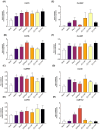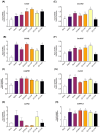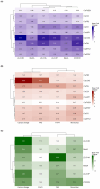Genotype-dependent responses to HIPV exposure in citrus: repression of CsPUB21 and activation of SA/JA signaling
- PMID: 40636014
- PMCID: PMC12237983
- DOI: 10.3389/fpls.2025.1605151
Genotype-dependent responses to HIPV exposure in citrus: repression of CsPUB21 and activation of SA/JA signaling
Abstract
Herbivore-induced plant volatiles (HIPVs) are known to activate immune signaling in plants; however, their effectiveness can vary depending on the genotype and the signaling pathway involved. In this study, we evaluated the transcriptional response of four citrus rootstocks (Carrizo citrange, Forner-Alcaide 5 (FA5), Forner-Alcaide 74 (FA74), and Microcitrus australasica) to six synthetic HIPVs [(Z)-3-hexen-1-ol, (Z)-3-hexenyl acetate, (Z)-3-hexenyl butyrate, (Z)-3-hexenyl propanoate, methyl jasmonate, and methyl salicylate]. We focused on genes associated with the salicylic acid (SA) and jasmonic acid (JA) pathways, as well as the susceptibility gene CsPUB21. Overall, the SA pathway was more consistently activated than the JA pathway, with upstream and intermediate genes induced across most genotypes and treatments. In contrast, downstream markers showed more variable expression, suggesting that synthetic HIPVs may induce a primed rather than fully activated defense state. Among the volatiles tested, (Z)-3-hexenyl propanoate and (Z)-3-hexen-1-ol were the most effective, activating genes in both pathways. Importantly, these two compounds also consistently repressed CsPUB21 expression, a gene recently associated with huanglongbing (HLB) susceptibility, through coordinated transcriptional and post-translational regulation. Carrizo citrange showed the strongest transcriptional response, while FA74 exhibited more moderate activation, emphasizing the influence of genetic background on HIPV perception and signaling. These findings highlight the potential of selected synthetic HIPVs as sustainable defense priming agents capable of enhancing citrus immunity by simultaneously activating immune pathways and repressing susceptibility genes such as CsPUB21. This dual mode of action offers promising tools for the integrated management of HLB and other citrus diseases.
Keywords: CsPUB21; abiotic stress; biotic stress; citrus rootstocks; defense gene expression; jasmonic acid signaling; salicylic acid pathway; volatile organic compounds.
Copyright © 2025 Ortells-Fabra, Gallego-Giraldo, Forner-Giner, Urbaneja and Pérez-Hedo.
Conflict of interest statement
MP and AU are inventors of the Spanish Patent No. P202030330 entitled “Use of (Z)-3-hexenyl esters and method for protecting plants against pests". The remaining authors declare that the research was conducted in the absence of any commercial or financial relationships that could be construed as a potential conflict of interest.
Figures






References
-
- Dahmane M., Urbaneja A., Ruíz-Rivero O., Alonso-Valiente M., Pérez-Hedo M. (2022). The zoophytophagous predator Pilophorus clavatus (Hemiptera: Miridae) induces plant defences in citrus. J. Pest Sci. 95, 1519–1530. doi: 10.1007/s10340-022-01558-5 - DOI
-
- Depalo L., Urbaneja A., Gallego C., Fournarakos A., Alonso M., Pérez-Hedo M. (2022). Eliciting sweet pepper plant resistance to Aulacorthum solani and attractiveness on Aphelinus abdominalis by exposure to (Z)-3-hexenyl propanoate. Entomol. Gen. 42, 743–749. doi: 10.1127/entomologia/2022/1595 - DOI
LinkOut - more resources
Full Text Sources

